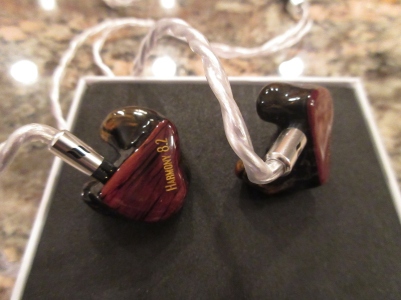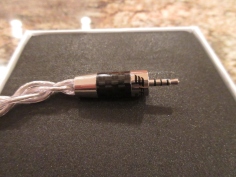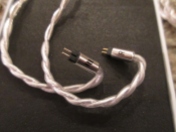Silver Lightning.
PROS: quality material and workmanship, surprisingly flexible 22awg, unique sound characteristics for a silver wire.
CONS: weight, sound improvement varies depending on pair up.
The product was provided to me free of charge for the review purpose in exchange for my honest opinion.
Manufacturer website: Effect Audio, for sale on MusicTeck.
Preamble.
Aftermarket premium replacement cables have been a controversial topic of discussions in many audio communities. There are some who don’t hear a sound improvement and others who consider the improvement to be too subtle to justify the cost. Some are firm believers (myself including) who do actually hear the change in sound, while others talk themselves into believing to validate their purchase. I also ran into a group of people who consider cables as another accessory to personalize the appearance, just like they would with CIEM customization, or those who switch from single ended to balanced and take the opportunity to upgrade to fancier wires. And then you have a group who never tried a replacement cable and formed their opinion based on reading someone else’s rant.
From my personal experience, I do hear and feel the change in a sound, but I’m not able to capture it accurately in measurements. The most obvious change even disbelievers can agree on is that higher purity material will yield a smaller resistivity, better conductivity, and corresponding boost in signal level. Also, various metals have different properties. There is no magic behind it and you’ll get an instant benefit of slightly higher output driving your transducers, something that could be measured. But when I hear a change in bass tonality, tightness, articulation, or I hear more airiness in treble or overall improvement in retrieval of details which feels like a layer of veil is lifted off – this is not easy to capture. Considering we all have a different perception of sound, without supporting measurements some people jump into conclusion and form a “snake oil” opinion, especially when price is taken into consideration.
The intent of this review is not to change anybody’s mind, but rather to share with you what I hear and how I hear it. Perhaps, I can’t fully explain why there is a change in sound, but I do hear it and would like to describe it. What makes sense to me is that I look at the wire as a material with physical properties of resistivity, conductivity, level of purity, etc, which acts as a filter between your source and headphones. Variations of these physical properties will affect the electric signal and result in a sound change, from a subtle to a more noticeable level. Also, I want to talk about the design of these cables, to make people understand why they cost so much, and that you are not dealing with a “coat hanger” wire but rather high grade materials, advanced production techniques, and hours of labor which all add up to a premium cost. Last but not least, the sound improvement of one particular cable is not universal because it will depend on the synergy between your source and your headphones.
Intro.
Back in the days when I started reviewing budget IEMs and then moved to mid-fi and TOTL models, I saw a drastic increase in price while the sound improvement wasn’t necessary at the same “drastic” level. That’s when I learned about “diminishing returns” where you can’t expect that 2x increase in price will yield a double improvement in sound quality. It just the way how things work in audio gear world. Then, when I got into reviewing of $1k-$2k flagships, I also noticed a number of people who wanted to squeeze every bit of sound improvement without minding of paying a premium price to reach their ultimate goal. Aftermarket cables have been one of the most popular upgrades in this category, and not just to personalize the look but also to improve the sound quality over a stock OFC cable. Maybe it’s a niche market, but there are people who’re ok with a price of high quality premium cable reaching the price of C/IEM itself, and they are willing to go down the path of diminishing returns.
Effect Audio (EA) was founded in 2009 by Suyang, an electrical engineering student while still at school, who invested a lot of time doing research, testing, and development of prototypes to come up with a solution to upgrade stock cables of the popular earphones. His hard work and workmanship skills were quickly recognized, and as a result he shifted his focus from basic cables to a more premium wire material. The first time I heard of EA was while reading about their flagship Mars GPS cable, a high price cable even by my standards. I didn’t look closer into their catalog and completely missed a selection of other more affordable premium cables. When I got an opportunity to test their latest Silver Thor II+ cable, I put it right into action while reviewing S-EM9 where it yielded an excellent pair up synergy. Now, after having a chance to properly test it with a handful of other premium TOTL iems, I would like to share with you about my experience.
Unboxing and accessories.
Arriving from overseas, I did expect a more secure packaging, but didn’t expect a rather neat small cardboard box with a clever “donut” cutout of the foam block with a cable securely wrapped inside of it. Unlike some other packaging boxes which get discarded after opening, I found EA box to be very useful for storage and organizing of the cable (without IEMs attached, not enough room otherwise) and keeping wires from being tangled. It even had enough room to include the adapter which I received as an accessory to the cable.
The cable usually doesn’t require accessories, though I wouldn’t mind seeing a case. Also, I do wish for aftermarket cables to include one of those leather strap cable organizers with a snap button. Just a wishful thinking. In case of my review unit, there was one included accessory: 2.5mm to 3.5mm adapter (has to be purchased separately). Ever since my DAP review collection started to expand, I now have a lot of audio sources with a balanced 2.5mm output. Having two separate cables with different terminations is not efficient and will be costly. Instead, it makes sense to get balanced terminated cable and a single ended adapter or whatever other connection you require.
Thus, every cable I get now is terminated with 2.5mm TRRS balanced connectors and I add an adapter. Typically such adapters have two separate male and female connectors joined by a short cable extension. It works, but could adds more bulk and length to the cable. Plus, if you are using specific premium wires, you also need to keep adapter consistent with the same wire material. Some cable manufacturers do offer a single piece adapter (straight and angled) which makes the design clean, but sometimes it looks a bit diy-ish. Effect Audio adapter looks very pro, all metal, and very durable. I requested the right angled version of the adapter, but you can also ask for a straight one. Depending on the location of your headphone jack, sometimes one is more convenient than the other.
2.5mm TRRS to 3.5mm TRS adapter.
Design.
The cable design starts with a wire, and here we got 22awg UPOCC Pure Silver Litz design. For those unfamiliar, UP-OCC manufacturing refers to Ultra-Pure Ohno Continuous Casting process developed and patented by Professor Ohno of CIT in Japan. Also, the multi-stranded Litz wires are usually a good choice to improve conductivity since the electric signal typically travels on the surface rather than through the core, and having multiple wire strands increases the effective surface area. Actually, according to EA design description, they are using proprietary multi-size stranded design within single encapsulation.
When I got Thor II+ out of the box, what surprised me the most was flexibility of the cable. We are talking about 4 braids of 22 gauge thick wire which I was able to easily wrap around 3-finger loop for storage. The cable insulation has a rubbery texture and looks crystal clear where you can see every strand of the wire like under microscope. Also, after unwrapping, I didn’t find any wire memory effect, the cable straighten out quickly thanks to flexible insulation which is apparently the same as the one used in EA’s new flagship Leonidas cable.
Starting with headphone plug, you have what appears to be a rhodium connector, in my case 2.5mm TRRS termination, with a hefty all metal plug housing branded with Effect Audio name/logo and carbon fiber insert. The 4-wire braid was not super tight, but also not very loose, just enough to keep the flexibility of the cable. Going up to y-splitter, you have a machined aluminum piece matching the headphone plug with the same company branding and CF insert. Both connector and y-splitter are on a bulky side and do add to the weight of the cable, but at the same time they look very premium.
You will also find a clear rubbery chin slider, not just a piece of shrink-wrap but a legitimate custom slider. From y-splitter, the 4-wire braid splits into 2 twisted pairs going up to each headphone connector. Before the connector you have a pre-shaped clear silicone earhook tube without a metal memory wire. I’m not a big fan of memory wires because of the re-shaping required every time you unwind the cable after storage. This type of pre-shaped earhook is very convenient. The 2pin headphone plugs are universal (typical 0.78mm diameter), adequate for both surface and recessed shell sockets, and with a matching aluminum slim capsule housing with L/R labeling and EA logo.
It’s definitely a fine looking cable with a sexy “silver” appeal throughout every element of the design. But the thickness of the wires and the added bulk of the connectors and the splitter makes this cable a bit heavy at 46g (54g with an attached adapter). It’s not the end of the world and actually on par with other thicker multi-braided cables. But if you are looking for a lightweight IEM cable while on the move, Thor II+ will be a little too heavy for that task.
Sound analysis.
While sound analysis is an important part of all of my reviews, when it comes to cables I find it hard to describe the sound of the wire because in reality I’m describing the sound of headphones attached to it, along with a synergy of the source used for testing. There are just too many variables between the source and your ears which makes it hard to zoom in right into the performance of the cable. But once you start switching between different IEMs and cables, you can pick up on a common traits of the individual characteristics.
Based on my experience with previous testing of various SPC and Silver cables, I already have some expectations of what a silver material can do to a sound, which typically results in brighter, resolving, expanded characteristics. But after 100hrs of burn in, Silver Thor II+ turned out to be not like any other silver cable. It does add resolution and clarity, brings more details to vocals, expands perception of soundstage width, but at the same time keeps upper frequency brightness under control where it never crosses the threshold of harshness, even with bright analytically tuned C/IEMs. To my surprise it also improves bass texture, and even adds a little bit of rumble and impact.
If this would have been a blind test, I would probably assume that I’m dealing with some kind of a hybrid cable. It even reminds me of gold-plated TWau cable, though there is a noticeable difference where TWau contributes more to mid-bass impact while Thor II+ adds a little more sub-bass texture. Also, Thor II+ upper mids are a bit brighter, with more sparkle and more revealing, while TWau makes sound smoother, revealing, and more organic. I know I’m comparing apples and oranges in terms of the wire material, but it just demonstrates how cable manufacturers have their own unique cooking formulas which don’t always follow the expected and predictable “behavior” of the wire.
Pair up analysis.
In my individual cable reviews I usually don’t compare different cables to determine which one is better. It’s a subjective opinion where I found different cables refine the sound in a different way. But in my C/IEM reviews I do try various cables to find which one has the best pair up synergy. In my opinion, in pair up analysis it makes more sense to test the aftermarket cable against the stock cable. Thus, in the following analysis I will only talk about how Thor II+ (TII+) compares to a stock cable and will describe the improvement if I hear any. For the reference, in every test I’ve volume matched the output level by ear.
64audio U12 w/B1 (from OFC to TII+) – soundstage width is a little wider and I also hear improvement in depth perception where the sound has an improved 3D imaging. There is also a noticeable improvement in sub-bass extension, I hear a deeper rumble, and some improvement in mid-bass impact. Upper frequencies have more clarity, the sound is a little more revealing and resolving.

Earsonics S-EM9 (from OFC to TII+) – soundstage spreads wider from left to right. Bass is tighter and more articulate, and I hear more sub-bass rumble. Mids feel like a veil was lifted off, with more clarity, higher resolution, better retrieval of details, even improved layering and separation of the sound. Also, I found treble to have a little more sparkle. Stock OFC cable definitely doesn’t do S-EM9 justice and TII+ really scales up the sound.

CustomArt H8.2 (from OFC to TII+) – a rather noticeable improvement in soundstage width. Not just the bass but overall sound is tighter and faster (improved PRaT factor). Feels like a layer of veil was lifted off, but for my own personal taste I’m not so sure if I prefer this. I like the improvement in low end, the bass sounds tighter and cleaner, but upper mids/vocals are more forward and a little harsher now. I prefer a smoother and more natural tonality with OFC cable.

Noble K10UA (from SPC to TII+) – there is a slight improvement in soundstage width. Also, I hear a little improvement in sub-bass texture. Upper mids get brighter, closer to a threshold of my comfort level for harshness tolerance. The sound improvement is not very significant, and instead I hear mids/vocals get a little brighter and harsher which I’m not a big fan of. This is not the first time when I went back to a stock SPC cable with K10UA.

Zeus XRA (from SPC to TII+) – due to Zeus original wide soundstage, I can’t say for sure if it got any wider, maybe a subtle change. What I do hear is that bass got a little more texture, with more rumble in sub-bass, but the quantity didn’t go up by a lot. I still perceive it as an improved quality rather than quantity. The most noticeable change is in upper mids/treble where the sound is smoother. You still hear a very transparent and resolving non-analytical retrieval of details, but it feels more under control. If you want an improvement in bass quantity, this is not it. But it definitely refines the quality of the mids.

As you can see, some pair ups showed a more noticeable improvement while other ones not as much. That just proves my point that cable effect is not universal and will depend on the synergy with a particular pair of C/IEMs.
Conclusion.
When it comes to EA Thor Silver II+, I was impressed with a durable build and luxurious looks and was surprised this cable performed unlike other typical silver wires I’ve tested in the past. Its sound improvement characteristics, by adding texture and some impact in the bass and bright expansion without harshness or graininess in upper frequencies, is what makes it sound unique. I did mention that added weight might not be ideal for everyone, especially if you are looking for a lightweight cable on the go, but Thor II+ was still very comfortable to wear, especially considering 4 braids of 22 gauge wire which I found to be surprisingly flexible. Certainly, Thor II+ is one of their flagship cables with a price to reflect that, but Effect Audio and their Music Sanctuary distributor has an extensive catalog with other budget friendly alternatives to suite your needs when you are ready to upgrade the performance of your C/IEMs.


















Hi,
I owned U12. Which premium cable should I use to maximize the sound? Thanks.
LikeLike
For u12? Use alo ref8 cable, the best pair up, IMHO.
LikeLike
Hi How did ThorII+ sound with Shure 846?
Significant improvement?
LikeLike
Sorry, I don’t have 846. Tried it long time ago, found its mids too be too forward for my taste. Thor II+ will do good for 846 bass, but might also make upper mids and treble brighter.
LikeLike